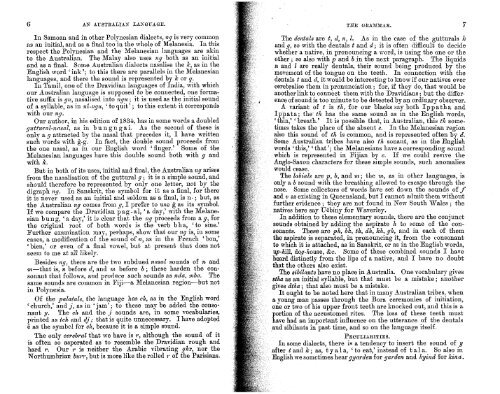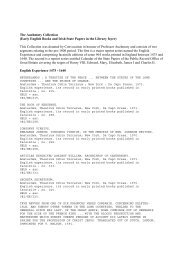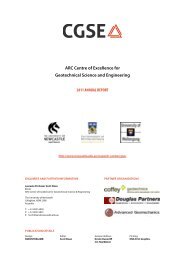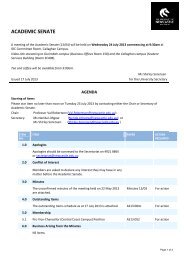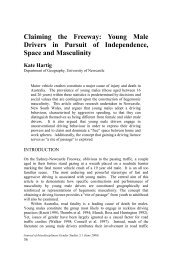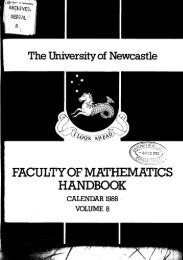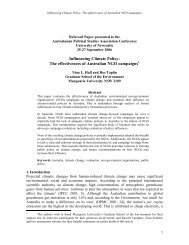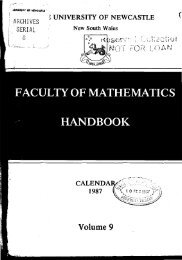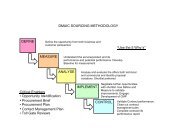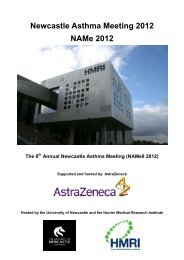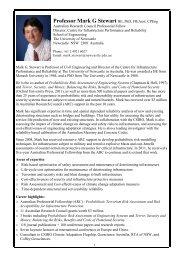n - University of Newcastle
n - University of Newcastle
n - University of Newcastle
Create successful ePaper yourself
Turn your PDF publications into a flip-book with our unique Google optimized e-Paper software.
In Samoaii and in other Polpilesian dialects, 12g is very common<br />
as an initial, and as a final too in the whole <strong>of</strong> Melanesia. In this<br />
respect the Polynesia~l and the Melanesian languages are akin<br />
to the Australian. The Malay also uses .~?y both as an iuitial<br />
and as s final. Some -%ustralian dialects nasdise the 7c, as in the<br />
English word ' ink '; to this there are parallels in the Melanesian<br />
languages, and there the sound is represented by k or p.<br />
In Tamil, one <strong>of</strong> th9 Dravidian languages <strong>of</strong> India, with which<br />
our Australian language is supposed to be connected, one formatire<br />
suffix is gzc, llasalised illto ng?~ : it is used as the initid sound<br />
<strong>of</strong> a syllable, as in 129-11~2~, ' to quit' ; to this extent it corresponds<br />
vith our 9zg.<br />
Our author, in his edition <strong>of</strong> 1834, has i11 some words a doubled<br />
gzctfz~ral-nasal, as in b u 11 g11 qr a i. As the second <strong>of</strong> these is<br />
only a g attracted by the nasal that precedes it, I have written<br />
such words n-it11 g-g. In fact, the double sound proceeds from<br />
the one nasal, as in our English word 'finger.' Some <strong>of</strong> the<br />
Melanesian languages hare this double sound both with y and<br />
with k.<br />
But in both <strong>of</strong> its uses, initial and final, the Australian 12y arises<br />
from the nnsalisation <strong>of</strong> the guttural g ; it is a simple sound, and<br />
should therefore l~e represented by only one letter, not by the<br />
digraph pig. In Sanskrit, the symbol for it as a final, lor there<br />
it is never used as an initial and selclom as a final, is n. ; but, as<br />
the Australia11 ng comes from g, I prefer to use g as its symbol.<br />
If me compare the Dravirlian 11 ag - al, ' a day,' with the Nelane-<br />
sian bung, ' a day,' it is clear that the xy proceeds from a g, for<br />
the original root <strong>of</strong> both words is the rerb bha, 'to sine.'<br />
Further examination may, perhaps, show that our 7t.q is, iu some<br />
cases, a modification <strong>of</strong>' the sound <strong>of</strong> 9, as in the French ' bon,'<br />
' bien,' or even <strong>of</strong> a final vonel, but at present that does not<br />
seem to me at a11 likely.<br />
Besides qzy, there are the two subdued qznsnl soullds <strong>of</strong> 12 and<br />
wz-that is, n before cl, and 112 before b; these harden the con-<br />
sonaiit that follotvs, aud prodnce such sounds as nda, 911bn. The<br />
same sounds are co~ui~loll in Fiji-a Nelanesian region-but not<br />
in Polynesia.<br />
Of the palnfals, the language has ch, as in the English word<br />
' church,' and j, as in 'jam' ; to these map be added the consonant<br />
y. The clr ancl the ,i souilds are, in some vocabularies,<br />
printed as tch aid dj; that is quite unnecessary. I have adopted<br />
6 as ihe symbc! for cA, because it is a simple sound.<br />
The only cerebral that me have is r, although the sound <strong>of</strong> it<br />
is <strong>of</strong>ten so aspemted as to resemble the Dravidian rough and<br />
hard r. Our r is neither the Arabic vibrating yhr, nor the<br />
Northumbriac l n r ~ but ~ , is more like the rolled r <strong>of</strong> the Parisians.<br />
TIIE CiRAJIMAR. 7<br />
The denfals are t, cl, 12, Z. As in the case <strong>of</strong> the gutturals k<br />
and g, so with the dentals t and d; it is <strong>of</strong>ten difficult to decide<br />
whether a native, in pronouncing a word, is using the one or the<br />
other ; so also with p and bin the nest paragraph. The liquids<br />
18 and I are really dentals, their sound being produced by the<br />
ds, there are the conjunct<br />
h to some <strong>of</strong> the con-<br />
JL, and in each <strong>of</strong> them<br />
it, from the consonant<br />
as in the English words,<br />
ome <strong>of</strong> these combined souncls I have<br />
lips <strong>of</strong> a native, and I have no doubt<br />
dustralian tribes, when<br />
PECULIARITIES.<br />
n some dialects, there is a tendency to insert the sound <strong>of</strong> y<br />
er t and 7c ; as, t y a 1 a, ' to eat,' instead <strong>of</strong> t a 1 a. So also in<br />
glish we somctimes hear ggarden for garden and Pyijad for kina.


